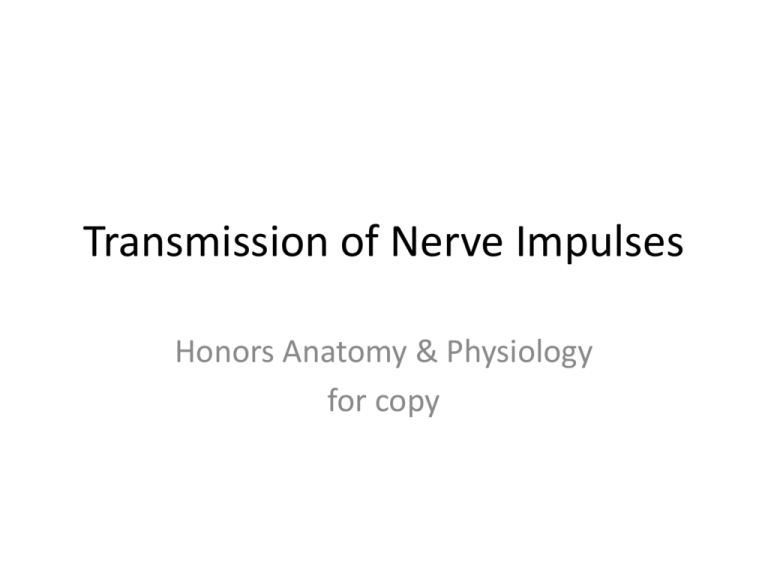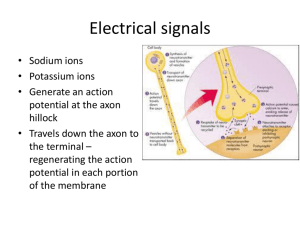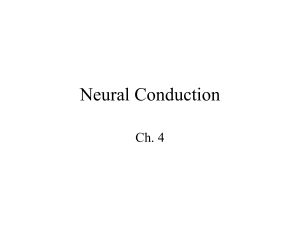Transmission of Nerve Impulses
advertisement

Transmission of Nerve Impulses Honors Anatomy & Physiology for copy Electrical Signals in Neurons • neurons are electrically excitable • 2 types of electrical signals: 1. graded potentials • only for short distance communication 2. action potentials • allow communication over both short & long distances Graded & Action Potentials • both depend on 2 basic features of plasma membrane in excitable cells: 1. existence of a resting membrane potential 2. presence of specific ion channels Membrane Potentials • electrical voltage difference across the membrane • flow of ions thru ion channels => flow of current Ion Channels • when open: allow specific ions to move across plasma membrane down their electrochemical gradient by diffusion – ions move down their concentration gradient & (+) charged cations move toward (-) charged anions Ion Channels • 4 types: 1. leakage channels 2. voltage-gated channels 3. ligand-gated channels 4. mechanically gated channels Leakage Ion Channels • channels randomly alternate (open/close) • typically are more K+ leakage channels than Na+ & K+ channels are leakier than Na+ – (so membranes more permeable to K+ than Na+) Voltage-Gated Channels • open in response to change in membrane potential • important in generation & conduction of action potentials Ligand-Gated Channels • open/ close in response to a specific chemical stimulus • ligands include: – neurotransmitters – hormones – particular ions • work in 1 of 2 ways: 1. directly: ligand molecule itself opens/closes gate 2. indirectly: ligand activates another molecule which in turn opens/closes gate Mechanically Gated Channels • gates open/close in response to mechanical stimulation in form of: – vibration (sound waves) – pressure (touch) – tissue stretching Resting Membrane Potential • exists because there is small build-up of (-) charge just inside plasma membrane small build-up of (+) charge just outside membrane • separation of charge source of PE • greater the difference in charge the larger the membrane potential (voltage) Resting Membrane Potential • neurons: membrane potentials range from • -90 mv to -40 mv • (-) indicates the inside of cell is (-) relative to the outside • cells with membrane potential are said to be polarized • most body cells are polarized with membrane potentials vary from +5 mv to -100 mv Generation of Action Potentials (AP) • 2 phases: (lasts ~ 1msec) 1. Depolarizing Phase – (-) membrane becomes less (-) 2. Repolarizing Phase – normal membrane potential restored AP Voltage-Gated Channels • 2 types of voltage-gated channels open & then close: – present mainly in axon plasma membrane & axon terminals • 1st to open: Na+ – Na+ rushes into cell – causes depolarization • then K+ channels open – K+ flows out of cell – produces repolarizing phase Action Potential Characteristics 1. “all-or-none” principle 2. threshold: (~ -55mv) must be reached for AP to occur Refractory Period • period of time after an AP begins during which an excitable cell cannot generate another action potential Propagation of Nerve Impulses • AP must travel from trigger zone axon terminal • this mode of travel called propagation or conduction – uses (+) feedback – when Na+ flows into cell it causes voltage-gated Na+ channels in adjacent segments to open Local Anesthetics • drugs that block pain & other somatic sensations – cold applied to area also produces anesthetic effect: axons propagate slower – ice partially blocks axon propagation of pain • examples: – Lidocaine, Novacaine • act by blocking the opening of voltage-gated Na+ channels: – sensory nerve impulses cannot travel past obstructed region so pain signals never make it to the brain Effect of Axon Diameter • larger diameter axons propagate impulses faster than smaller diameter ones due to larger surface area • Classified: 1. A-fibers: (5-20 μm) travel 12-130 m/s – used by somatic sensory neurons & motor neurons – found in sensory neurons going from viscera brain – all unmyelinated, found in some sensory for pain from skin and viscera & in autonomic motor fibers 2. B-fibers: (2-3 μm) travel 15 m/s 3. C-fibers: ( .5-1.5 μm) travel 0.5 – 2 m/s Signal Transmission @ Synapses • presynaptic neuron: neuron sending the AP • postsynaptic neuron: neuron receiving the AP • synapse: space between the 2 • synapses can be: 1. electrical 2. chemical Electrical Gap Junctions • common in visceral smooth muscle, cardiac muscle, & in developing embryo • 2 advantages to electrical synapses 1. faster communication – AP passes directly from presynaptic neuron postsynaptic neuron 2. synchronization – electrical synapses can coordinate the activity of a group of neurons or muscle fibers Chemical Synapses • synaptic cleft: space between filled with interstitial fluid • in response to AP axon terminal of presynaptic neuron releases neurotransmitters that diffuse across the synaptic cleft bind to receptors in plasma membrane of postsynaptic neuron producing a postsynaptic potential • electrical signal (AP) chemical signal (neurotransmitters) electrical signal (AP) Removal of Neurotransmitter • occurs in 3 ways: 1. diffusion 2. enzymatic degradation 3. uptake by cells Neurotransmitters • 2 classes: 1. small-molecule neurotransmitters 2. neuropeptides Plasticity in Nervous System • nervous system exhibits plasticity: capability to change based on experience • @ level of individual neurons: – sprouting new dendrites – synthesis of new proteins – changes in synaptic contacts with other neurons Regeneration in Nervous System • limited capacity to replicate or repair itself • until recently: thought was little or no repair done to damage in CNS: have found neuroglial cells more capable of this than previously appreciated • PNS: as long as cell body intact & Schwann cell active new axon can be regenerated Homeostatic Imbalances in the Nervous System • Multiple Sclerosis (MS) • progressive destruction of myelin sheaths of neurons in the CNS • autoimmune disorder • afflicts ~ 350,000 in USA (estimated) with: – >2x female/male – white > other races – diagnosis difficult but most diagnosed ages 20 - 50 MS Causes? • unknown but do see: • genetic susceptibility: having 1st degree relative with it increases your chances several-fold • possible association to living farther away from equator (?) so maybe something to do with vitamin D • possible association with history of herpes6, Epstein Barr virus, chlamydia Epilepsy • characterized by short, recurrent attacks of motor, sensory, or psychological malfunction • afflict ~1% of world’s population • http://www.dailymotion.com/video/xaigxc_br ain-animation-of-epilepticseizu_creation#.UaPsb0B-8TY Causes of Epilepsy 1. brain damage – most frequently from birth trauma 2. metabolic disturbances – hypoglycemia, hypocalcemia, uremia, hypoxia 3. infections – encephalitis or meningitis 4. toxins – alcohol, tranquilizers, hallucinogens 5. head injuries 6. tumors & abcesses of the brain Medical Terminology 1. Guillain-Barre Syndrome (GBS) – – acute demyelinating disorder in which macrophages strip axons of myelin in PNS may be response of immune system to bacterial infection 2. Neuroblastoma – – most common tumor in infants immature neurons (neuroblasts) grow in abdomen or adrenals 3. Neuropathy – any disorder that affects the nervous system but particularly a disorder of a cranial or spinal nerve example: Bell’s palsy








